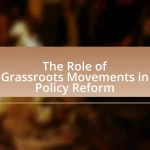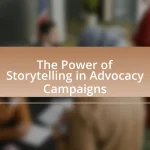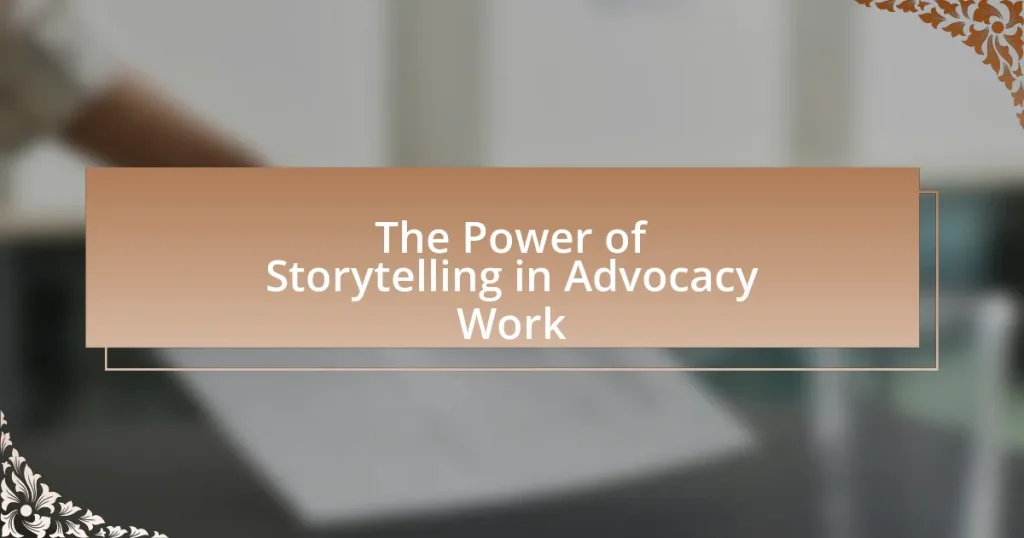The article explores the significant role of storytelling in advocacy work, emphasizing its ability to create emotional connections and drive engagement. It highlights how personal narratives and compelling stories can humanize complex issues, enhance empathy, and motivate action, ultimately influencing public opinion and policy decisions. Key elements of effective storytelling, such as clear messaging, relatable characters, and emotional resonance, are discussed, along with strategies for advocates to utilize storytelling techniques effectively. The article also addresses the impact of visual storytelling and the importance of understanding the target audience to enhance advocacy efforts.

What is the Power of Storytelling in Advocacy Work?
The power of storytelling in advocacy work lies in its ability to create emotional connections and drive engagement. Storytelling humanizes complex issues, making them relatable and compelling, which can influence public opinion and policy decisions. Research indicates that narratives can increase empathy and understanding; for instance, a study published in the journal “Science” found that stories can enhance the retention of information and motivate action more effectively than statistics alone. By framing advocacy messages within personal stories, advocates can mobilize support and foster a sense of urgency around their causes.
How does storytelling influence advocacy efforts?
Storytelling significantly influences advocacy efforts by creating emotional connections that engage audiences and motivate action. When advocates share personal narratives or compelling stories, they humanize complex issues, making them relatable and easier to understand. Research indicates that stories can increase empathy and retention of information; for instance, a study published in the journal “Science” found that narratives can enhance the persuasiveness of messages by up to 20%. This emotional engagement often leads to increased support for causes, as individuals are more likely to act when they feel a personal connection to the story being told.
What are the key elements of effective storytelling in advocacy?
The key elements of effective storytelling in advocacy include a clear message, emotional connection, relatable characters, and a compelling narrative structure. A clear message ensures that the audience understands the core issue being addressed, while an emotional connection engages the audience on a personal level, making them more likely to empathize with the cause. Relatable characters, often representing those affected by the issue, help to humanize the story and foster a deeper understanding. A compelling narrative structure, which typically includes a beginning, middle, and end, guides the audience through the story, creating a sense of urgency and prompting action. These elements are supported by research indicating that stories with emotional resonance are more persuasive and memorable, as demonstrated in studies by the Stanford Graduate School of Business, which found that narratives can significantly influence attitudes and behaviors.
How does emotional engagement enhance advocacy storytelling?
Emotional engagement enhances advocacy storytelling by creating a deeper connection between the audience and the message. When stories evoke emotions, they foster empathy, making the audience more likely to relate to the issues presented. Research indicates that emotionally charged narratives can increase retention of information by up to 65%, as people are more likely to remember stories that resonate with them on a personal level. This emotional resonance not only captures attention but also motivates action, as individuals feel compelled to support causes that they emotionally connect with.
Why is storytelling essential for advocacy success?
Storytelling is essential for advocacy success because it effectively engages audiences and fosters emotional connections. By presenting complex issues in relatable narratives, advocates can simplify their messages, making them more accessible and memorable. Research shows that stories can increase information retention by up to 65%, compared to facts alone, as highlighted in a study by the University of California, Berkeley. This emotional resonance not only motivates individuals to take action but also builds community support, amplifying the advocacy efforts.
What role does storytelling play in raising awareness?
Storytelling plays a crucial role in raising awareness by creating emotional connections that engage audiences and facilitate understanding of complex issues. Through narratives, individuals can relate to experiences that may be outside their own, making abstract concepts more tangible. For instance, research published in the journal “Health Communication” demonstrates that stories can significantly increase empathy and retention of information, leading to greater awareness of health-related issues. This emotional engagement is essential for advocacy, as it motivates individuals to take action and support causes they may not have previously considered.
How can storytelling drive action and mobilize support?
Storytelling can drive action and mobilize support by creating emotional connections that resonate with audiences. When narratives are crafted to highlight personal experiences or societal issues, they evoke empathy and inspire individuals to engage. For instance, studies show that stories can increase information retention by up to 65%, making the message more impactful. Additionally, storytelling can illustrate the consequences of inaction, motivating people to contribute to a cause. Research from the Stanford Graduate School of Business indicates that narratives can influence decision-making and behavior, demonstrating their effectiveness in advocacy efforts.
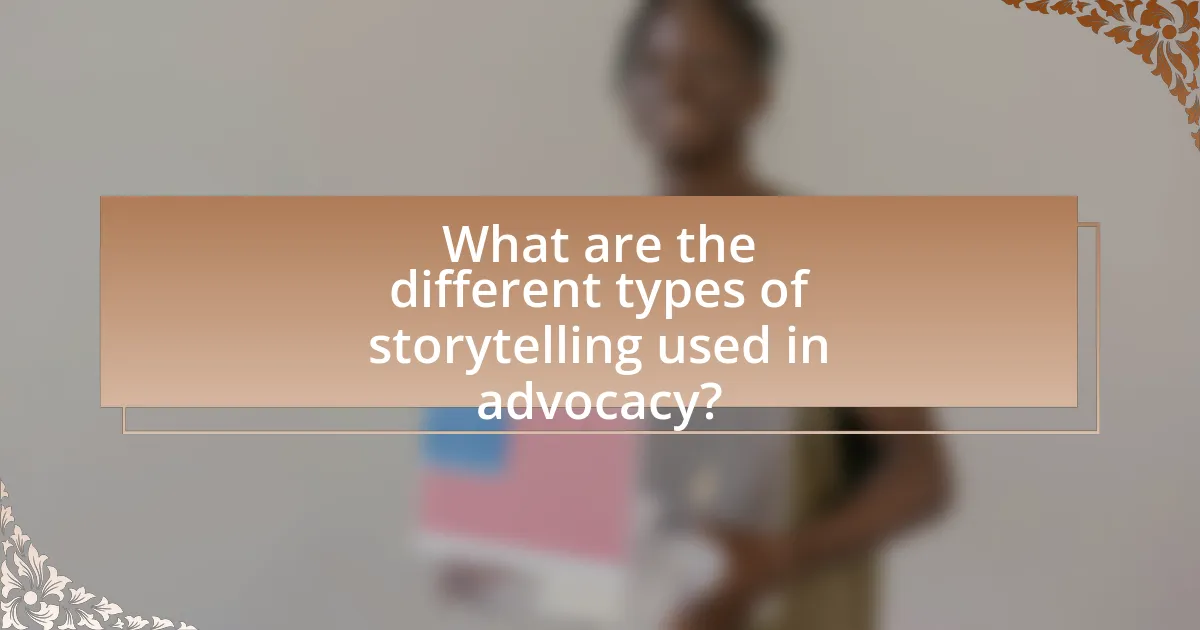
What are the different types of storytelling used in advocacy?
Different types of storytelling used in advocacy include personal narratives, data-driven stories, and collective storytelling. Personal narratives involve individuals sharing their experiences to create emotional connections and highlight issues, such as a survivor recounting their journey to raise awareness about domestic violence. Data-driven stories utilize statistics and research to support claims and demonstrate the scale of an issue, like presenting data on climate change impacts to advocate for environmental policies. Collective storytelling brings together multiple voices and experiences to illustrate a broader social issue, often seen in community organizing efforts where diverse perspectives unite to advocate for change. Each type effectively engages audiences and drives advocacy efforts by making complex issues relatable and urgent.
How do personal narratives impact advocacy campaigns?
Personal narratives significantly enhance advocacy campaigns by fostering emotional connections and increasing relatability among audiences. When individuals share their personal experiences related to a cause, they humanize complex issues, making them more accessible and compelling. Research indicates that narratives can lead to greater engagement; for instance, a study published in the journal “Health Communication” found that personal stories can increase message retention and motivate action, as they evoke empathy and understanding. This emotional resonance often translates into increased support for the advocacy efforts, demonstrating the effectiveness of storytelling in mobilizing communities and influencing public opinion.
What makes personal stories resonate with audiences?
Personal stories resonate with audiences because they evoke empathy and create emotional connections. When individuals share their experiences, they often reveal vulnerabilities and authentic emotions, which allow listeners to relate on a personal level. Research indicates that narratives activate the brain’s mirror neurons, fostering a sense of shared experience and understanding. For instance, a study published in the journal “Cognitive Science” by Paul Zak found that storytelling can increase oxytocin levels, a hormone associated with bonding and empathy, thereby enhancing audience engagement and response. This emotional engagement is crucial in advocacy work, as it can motivate action and inspire change.
How can advocates effectively share their personal experiences?
Advocates can effectively share their personal experiences by utilizing structured storytelling techniques that engage their audience emotionally and intellectually. This involves clearly defining the narrative arc, which includes a relatable beginning, a conflict or challenge, and a resolution that highlights the lessons learned. Research indicates that storytelling can increase retention of information by up to 65% compared to facts alone, as demonstrated in a study published in the journal “Cognitive Science” by researchers at the University of California, Berkeley. By incorporating vivid details and authentic emotions, advocates can create a connection with their audience, making their experiences more impactful and memorable.
What role do visual stories play in advocacy?
Visual stories play a crucial role in advocacy by effectively conveying complex issues and emotions, making them more relatable and engaging for audiences. They utilize imagery, video, and graphics to simplify narratives, allowing advocates to communicate their messages powerfully and memorably. Research indicates that visual content is processed 60,000 times faster than text, enhancing audience retention and understanding. This efficiency is vital in advocacy, where capturing attention and eliciting emotional responses can drive action and support for causes.
How can images and videos enhance storytelling in advocacy?
Images and videos enhance storytelling in advocacy by providing visual context that evokes emotional responses and fosters deeper connections with the audience. Visual content can illustrate complex issues more effectively than text alone, making the message more accessible and relatable. For instance, a study by the Stanford Graduate School of Business found that people are more likely to remember information presented with images than with text, highlighting the effectiveness of visual storytelling in retaining attention and conveying messages. Additionally, videos can showcase real-life testimonials and experiences, creating a sense of authenticity and urgency that can mobilize support for advocacy efforts.
What are the best practices for creating visual advocacy stories?
The best practices for creating visual advocacy stories include focusing on a clear narrative, using compelling visuals, and engaging the audience emotionally. A clear narrative ensures that the message is easily understood, while compelling visuals, such as photographs or infographics, enhance the storytelling by making complex information more accessible. Engaging the audience emotionally is crucial, as studies show that emotional connections can significantly increase the likelihood of action or support for a cause. For instance, research by the Stanford Social Innovation Review highlights that stories that evoke empathy can lead to greater engagement and advocacy.
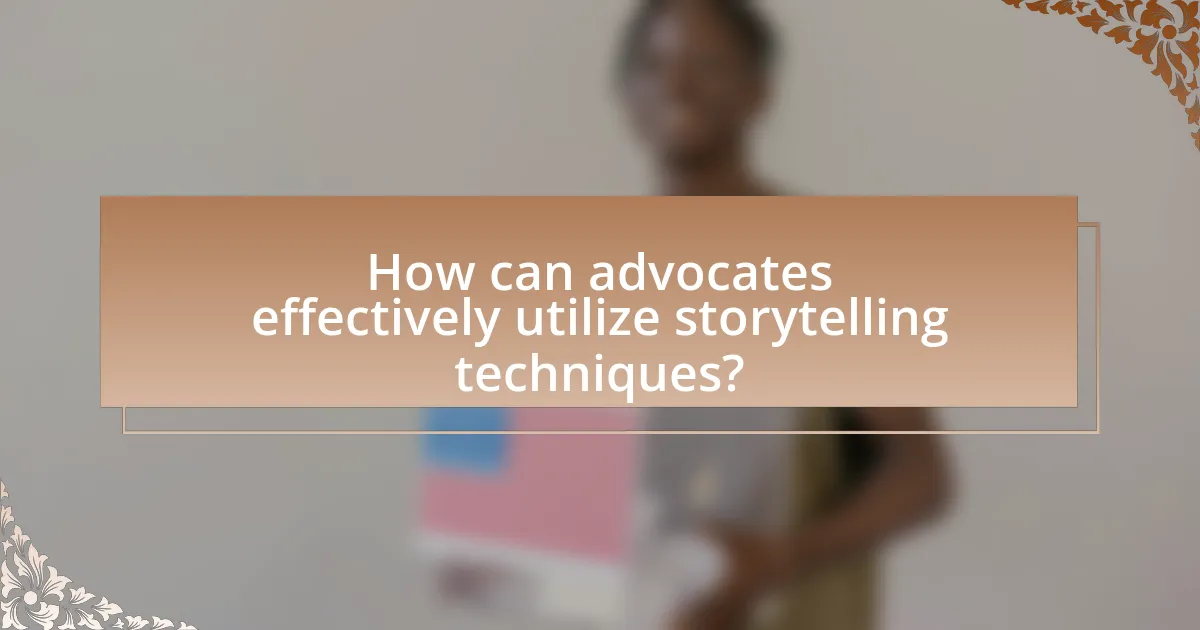
How can advocates effectively utilize storytelling techniques?
Advocates can effectively utilize storytelling techniques by crafting narratives that resonate emotionally with their audience, thereby fostering connection and understanding. This involves identifying a relatable protagonist, presenting a clear conflict, and illustrating a resolution that aligns with the advocacy goals. Research indicates that stories can increase engagement and retention of information; for instance, a study published in the journal “Psychological Science” found that narratives can enhance persuasion by up to 50%. By employing these techniques, advocates can transform complex issues into compelling stories that inspire action and drive change.
What strategies can enhance storytelling in advocacy work?
Effective strategies to enhance storytelling in advocacy work include using personal narratives, employing emotional appeal, and integrating data-driven insights. Personal narratives create a relatable connection, as individuals are more likely to engage with stories that reflect real-life experiences. Emotional appeal is crucial; research shows that emotionally charged stories can increase empathy and motivate action, as evidenced by studies indicating that emotional storytelling can lead to a 50% increase in audience engagement. Additionally, incorporating data-driven insights strengthens the narrative by providing factual context, which can enhance credibility and persuade stakeholders, as demonstrated by advocacy campaigns that successfully combined personal stories with statistics to drive policy change.
How can advocates identify their target audience for storytelling?
Advocates can identify their target audience for storytelling by conducting thorough audience analysis, which includes demographic research, psychographic profiling, and understanding the specific needs and interests of potential supporters. This process involves gathering data on age, gender, location, values, and motivations to tailor narratives that resonate with the audience. For instance, a study by the Pew Research Center highlights that understanding audience demographics can significantly enhance engagement, as tailored messages are more likely to connect with individuals’ experiences and beliefs. By utilizing surveys, social media analytics, and community feedback, advocates can refine their storytelling approach to effectively reach and influence their desired audience.
What techniques can be used to craft compelling narratives?
Techniques to craft compelling narratives include using character development, emotional appeal, and a clear structure. Character development allows audiences to connect with relatable figures, enhancing engagement. Emotional appeal evokes feelings that resonate with the audience, making the message more impactful. A clear structure, often following a beginning, middle, and end format, helps maintain coherence and guides the audience through the narrative. Research by the University of Pennsylvania highlights that stories with emotional resonance are 22 times more memorable than facts alone, reinforcing the effectiveness of these techniques in advocacy storytelling.
What are common challenges in storytelling for advocacy?
Common challenges in storytelling for advocacy include oversimplification of complex issues, audience disengagement, and the difficulty of conveying emotional resonance. Oversimplification can lead to misrepresentation of the advocacy issue, as nuanced details may be lost, resulting in a lack of understanding among the audience. Audience disengagement often occurs when stories fail to connect with the values or interests of the target demographic, making it essential for advocates to tailor their narratives effectively. Additionally, conveying emotional resonance is challenging, as stories must evoke empathy and action without appearing manipulative, which can alienate potential supporters. These challenges highlight the need for careful crafting of narratives that balance clarity, engagement, and emotional impact.
How can advocates overcome barriers to effective storytelling?
Advocates can overcome barriers to effective storytelling by employing clear messaging, understanding their audience, and utilizing diverse mediums. Clear messaging ensures that the core message is easily understood, which is crucial as studies show that concise narratives are more memorable and impactful. Understanding the audience allows advocates to tailor their stories to resonate emotionally, as research indicates that emotionally charged stories are more persuasive. Utilizing diverse mediums, such as video, social media, and live presentations, can enhance engagement and reach broader audiences, supported by data showing that multimedia storytelling increases retention rates by up to 60%.
What pitfalls should advocates avoid in their storytelling efforts?
Advocates should avoid oversimplifying complex issues in their storytelling efforts. Oversimplification can lead to misunderstandings and diminish the nuances of the advocacy cause, ultimately alienating potential supporters. For instance, a study by the FrameWorks Institute highlights that narratives lacking depth can misrepresent the realities of social issues, resulting in ineffective advocacy. By ensuring that stories reflect the complexity of the issues at hand, advocates can foster a more informed and engaged audience.
What practical tips can improve storytelling in advocacy work?
To improve storytelling in advocacy work, focus on crafting a clear and compelling narrative that resonates with your audience. Engaging storytelling should include relatable characters, a conflict that highlights the issue, and a resolution that inspires action. Research shows that narratives with emotional appeal can increase persuasion; for instance, a study published in the Journal of Personality and Social Psychology found that stories can enhance the effectiveness of persuasive messages by up to 50%. Additionally, using data and personal anecdotes can strengthen your message, as statistics provide credibility while personal stories create emotional connections.
How can advocates measure the impact of their storytelling efforts?
Advocates can measure the impact of their storytelling efforts through quantitative metrics such as engagement rates, reach, and conversion rates. For instance, tracking social media shares, comments, and likes provides data on audience engagement, while website analytics can reveal how many visitors were driven by storytelling content. Additionally, surveys and feedback forms can assess audience perception and emotional response, offering qualitative insights into the effectiveness of the narratives. Research indicates that storytelling can increase message retention by up to 65%, highlighting its potential impact on advocacy efforts.
What resources are available for advocates to enhance their storytelling skills?
Advocates can enhance their storytelling skills through various resources, including workshops, online courses, and books focused on narrative techniques. For instance, organizations like the Moth offer storytelling workshops that teach the art of personal storytelling, while platforms such as Coursera and Udemy provide online courses specifically tailored to storytelling in advocacy. Additionally, books like “Made to Stick” by Chip Heath and Dan Heath and “The Story Factor” by Annette Simmons provide valuable insights into effective storytelling strategies. These resources are designed to equip advocates with the necessary skills to craft compelling narratives that resonate with their audiences.




